Abstract
Although Cu–Al2O3 composites have good comprehensive performance, higher mechanical properties and arc erosion resistance are still required to meet heavy-duty applications such as electromagnetic railguns. In this work, a novel hybrid SiCw/Cu–Al2O3 composite was successfully prepared by combining powder metallurgy and internal oxidation. The microstructure and mechanical behavior of the SiCw/Cu–Al2O3 composite were studied. The results show that nano-Al2O3 particles and micro-SiCw are introduced into the copper matrix simultaneously. Well-bonded interfaces between copper matrix and Al2O3 particles or SiCw are obtained with improved mechanical and arc erosion resistance of SiCw/Cu–Al2O3 composite. The ultimate tensile strength of the SiCw/Cu–Al2O3 composite is 508.9 MPa, which is 7.9 and 56.1% higher than that of the Cu–Al2O3 composite and SiCw/Cu composite, respectively. The strengthening mechanism calculation shows that Orowan strengthening is the main strengthening mechanism of the SiCw/Cu–Al2O3 composite. Compared with Cu–Al2O3 composite, the hybrid SiCw/Cu–Al2O3 composite has lower arc time and energy and better arc stability.
Graphical abstract
Copper matrix composites reinforced with nano-Al2O3 particles and micro-SiC whiskers were prepared. Nano-Al2O3 particles are uniformly dispersed in the copper matrix (Figure a), and there is an obvious amorphous transition layer at the interface between the copper matrix and SiCw (Figure d). Nano-Al2O3 particles and micro-SiC whiskers reinforcing phase synergistically strengthen the SiCw/Cu–Al2O3 composite.
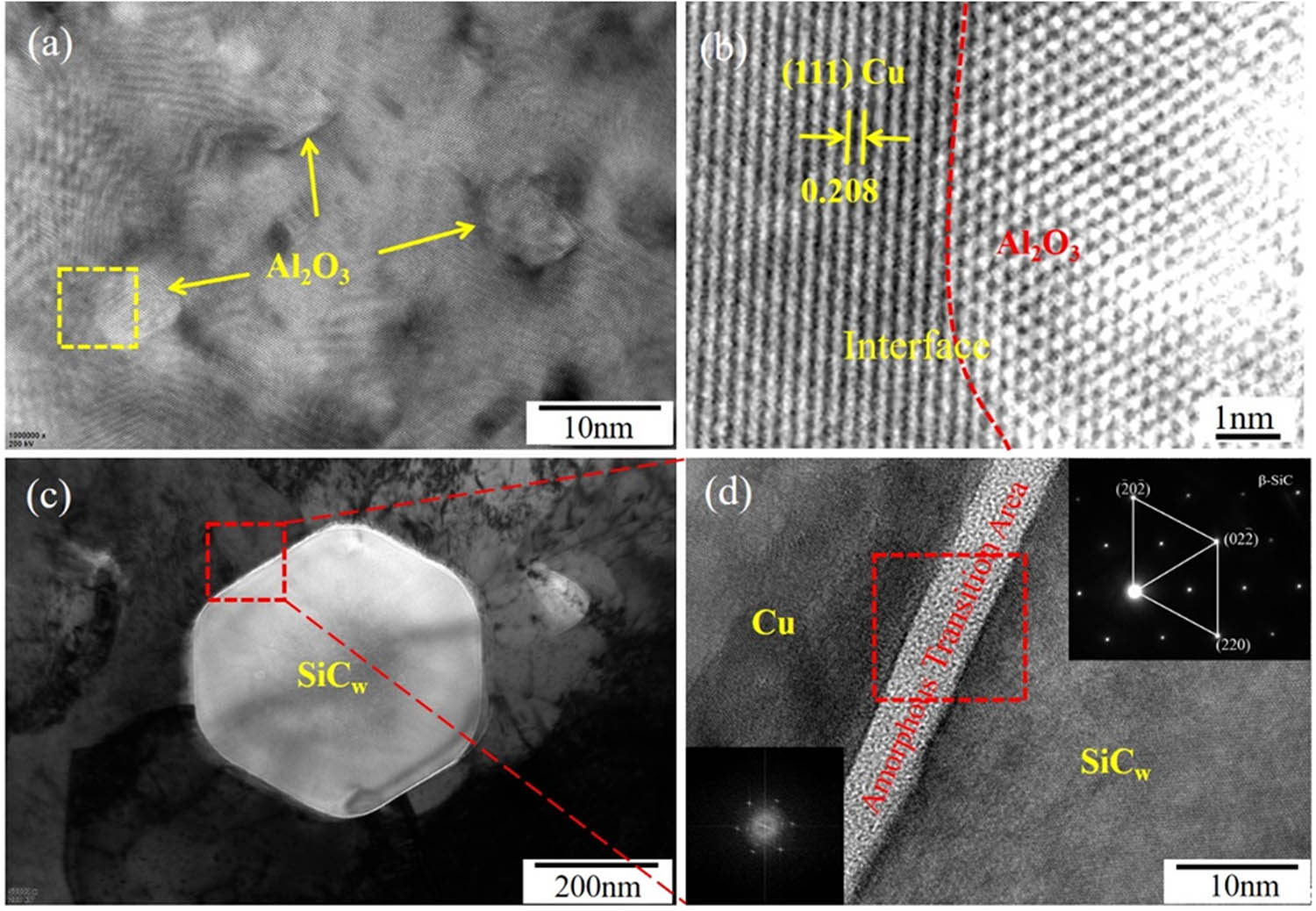
1 Introduction
Cu–Al2O3 composites have a wide range of applications in electrical contact due to their excellent conductivity [1] and high strength at elevated temperatures. For example, in the electromagnetic railguns system, the guide rail is seriously worn and partly melted due to the high projectile launching speed and driving current of the armature/guide rail system [2]. This kind of equipment puts forward higher requirements on mechanical properties [3], current-carrying friction and wear resistance, and arc erosion resistance of materials [4]. However, the commercial Cu–Al2O3 composites cannot meet the above requirements, and copper matrix materials used in the guide rail with better mechanical and electrical erosion resistance are still not developed.
Recently, hybrid copper matrix composites with two or more reinforcing phases have present better performance compared with the copper matrix composites reinforced by a single reinforcement [5]. And, the reported papers on synergistic reinforcements are mainly focused on CNTs [6]; Cr [7] and WC particles [8] strengthened the Cu–Al2O3 composite [9]. For example, Zhang et al. [10] reported that the ultimate tensile strength of a Cu–Al2O3–La composite was 309 MPa. Pan et al. [11] found that the ultimate tensile strength (345 MPa) of Cu–6.1 vol% CNTs–1.2 vol% Al2O3 composite was 41.1% higher than that of Cu-CNTs composite. Singh and Gautam [12] discovered that the ultimate tensile strength of Cu–0.5 vol% WC–5.0 vol% Al2O3-2.4 vol% Cr composite (385 MPa) was 71.9% higher than that of pure copper (224 MPa). Although the addition of particles or whiskers is beneficial to improve the mechanical properties of Cu–Al2O3 composites, their ultimate tensile strength are still under 400 MPa [13]. The reason for the low mechanical property is the poor interface bonding between reinforcements and copper matrix, in which the reinforced phases are introduced into the copper matrix by a common powder metallurgy process [14]. However, hybrid copper-based materials with high mechanical properties fabricated by in-situ synthesis have not yet been reported.
Currently, SiCw has become a potential reinforcement phase in copper-based materials, which has the advantages of low density [15], high strength [16], corrosion resistance [17], and high-temperature stability [18]. The object of this work is to develop a novel SiCw/Cu–Al2O3 composite with well-bonded interfaces between copper matrix and reinforcements. And, the preparation procedure combined powder metallurgy and internal oxidation, and the nano-Al2O3 particles and micro-SiCw were introduced into the copper matrix simultaneously. The well-bonded interfaces between copper matrix and Al2O3 particles or SiCw are obtained with improved mechanical and arc erosion resistance. The strengthening mechanisms of the SiCw/Cu–Al2O3 composite were calculated and discussed. The fabrication procedures and experimental results can provide a reference for the design and preparation of high-performance copper matrix composites.
2 Experiment
2.1 Materials and methods
The raw materials used in the preparation of composites are Cu–0.2 wt% Al alloy powders (99.6% purity, the median particle size of 40 µm, Hunan Huabang Powder Material Co., Ltd), Cu2O powders (provide oxygen for internal oxidation, 99.8% purity, the median particle size of 1 µm, Shanghai Xiangtian Nano Materials Co., Ltd), and SiC whiskers (98% purity, 5–10 µm length and 0.5 µm diameter).
The experimental procedures were as follows: first, mixing of powders was performed. Cu–0.2 wt% Al alloy powder, Cu2O powder, and SiCw were mixed in appropriate proportions. The powders were blended by a QQM/B light ball mill for 16 h at 35 rpm and a ball-to-powder ratio of 5:1. Note that to realize the complete internal oxidation of Al to produce Al2O3 in the subsequent internal oxidation process, the mass ratio of Cu2O powder to Cu2O powder is calculated to be 1.1:1 [19] (M(Cu–0.2 wt% Al):M(Cu2O) = 56.8:1). Second, cold isostatic pressing was performed. The mixed powders were pressed into cylindrical samples (Φ50 × 40 mm) in LDJ200/600-300 cold isostatic press at a pressure of 210 MPa and held for 10 min. Third, sintering was performed. The obtained cylindrical samples were sintered in a tube furnace protected by argon at 950℃ for 3 h. (Nano-Al2O3 particles were formed in the chemical reaction of internal oxidation, and the specific process has been reported in ref. [20]). Finally, the sintered samples were put into a ZT-200-22Y vacuum sintering furnace under a hydrogen–argon atmosphere and kept at 900℃ for 2 h for reduction. To further improve the relative density of the copper matrix composites, the sintered samples were put into a YA32-315 four-column hydraulic press for hot extrusion, the extrusion ratio was 10:1, and bars with a diameter of 15 mm were obtained. For comparison, the Cu–Al2O3 composite, the SiCw/Cu composite, and the pure copper were prepared under the same conditions. The specific composition is listed in Table 1.
Composition of copper matrix composites (vol%)
| Materials | Cu | Al2O3 | SiCw |
|---|---|---|---|
| Cu | 100 | — | — |
| SiCw/Cu | 95.3 | — | 4.7 |
| Cu–Al2O3 | 99.1 | 0.9 | — |
| SiCw/Cu–Al2O3 | 94.4 | 0.9 | 4.7 |
2.2 Material characterization
The microstructures of composites were observed by inverted metallurgical microscopy (DMi8C, Leica Microsystems Inc). The transmission electron microscopy (TEM) samples were polished by a precision polishing system (GATAN691, USA), and the interface between the matrix and reinforcing phase was characterized by high-resolution transmission electron microscopy (HR-TEM; JEM-2100, JEOL, Japan). The grain size of the copper matrix composites was analyzed by field-emission scanning electron microscopy (FE-SEM; JSM-7800F, JEOL, Japan).
2.3 Performance tests
To evaluate the tensile strength of the composites, the samples were processed into rod-shaped tensile samples with a diameter of 5 mm and a gauge length of 25 mm. The tensile tests were performed by a tensile testing machine (AUTOGRAPH AG-I 250KN, Japan) by stretching along the extrusion direction with a tensile strain rate of 0.5 mm/min. Tensile fractures were analyzed by scanning electron microscopy (SEM; JSM-IT100, JEOL, Japan).
Electrical contact tests were carried out by an electrical contact tester (JF04C, Kunming Institute of Precious Metals, China) shown in Figure 1. As-extruded samples were processed into electrical contact samples with a diameter of 3.8 mm and a length of 10 mm. Each contact pair was tested for 5,000 operation times under resistance load, with a voltage of 24 V DC, a current of 15 A, an average contact force of 50 cN, and an electrode spacing of 2 mm. Data on arc energy and arcing duration were automatically recorded by the JF04C test system. The arc erosion morphologies of the cathode and anode contacts were observed by SEM (JSM-IT100, JEOL, Japan).
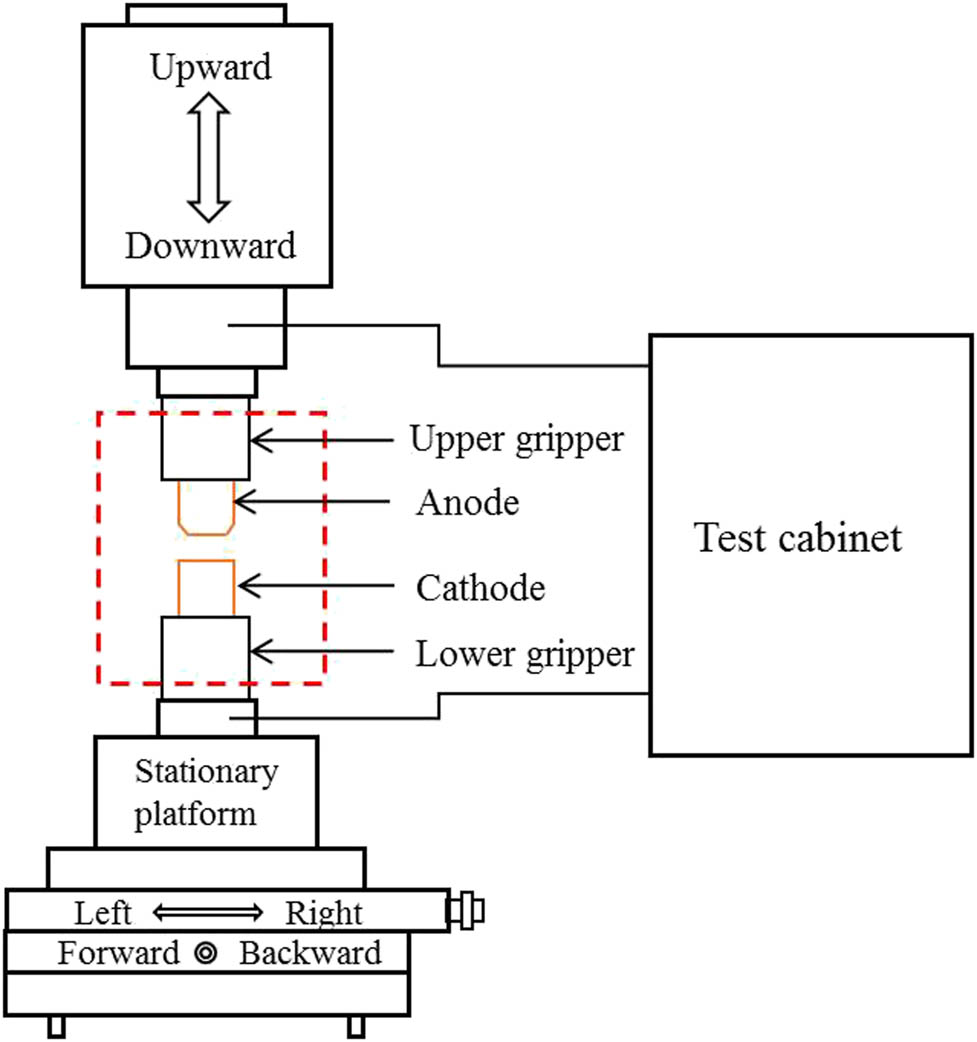
Schematic of JF04C electrical contact test apparatus.
3 Experimental results and discussion
3.1 The microstructure of the SiCw/Cu–Al2O3 composite
The metallographic structures of pure copper, the Cu–Al2O3 composite, and the SiCw/Cu–Al2O3 composite are presented in Figure 2. Comparing Figure 2a with Figure 2b shows that the grain size of the Cu–Al2O3 composite is smaller than that of pure copper, which indicates that Al2O3 particles are formed in the process of internal oxidation and can inhibit grain growth. Figure 2b and c show that compared with the Cu–Al2O3 composite, the grain size of the SiCw/Cu–Al2O3 composite has no obvious decrease, which indicates that the addition of SiCw has a certain influence on the grain size change but has little effect. Figure 2d shows that the SiC whiskers are arranged in an orderly manner and distributed along the extrusion direction without large-area agglomeration.
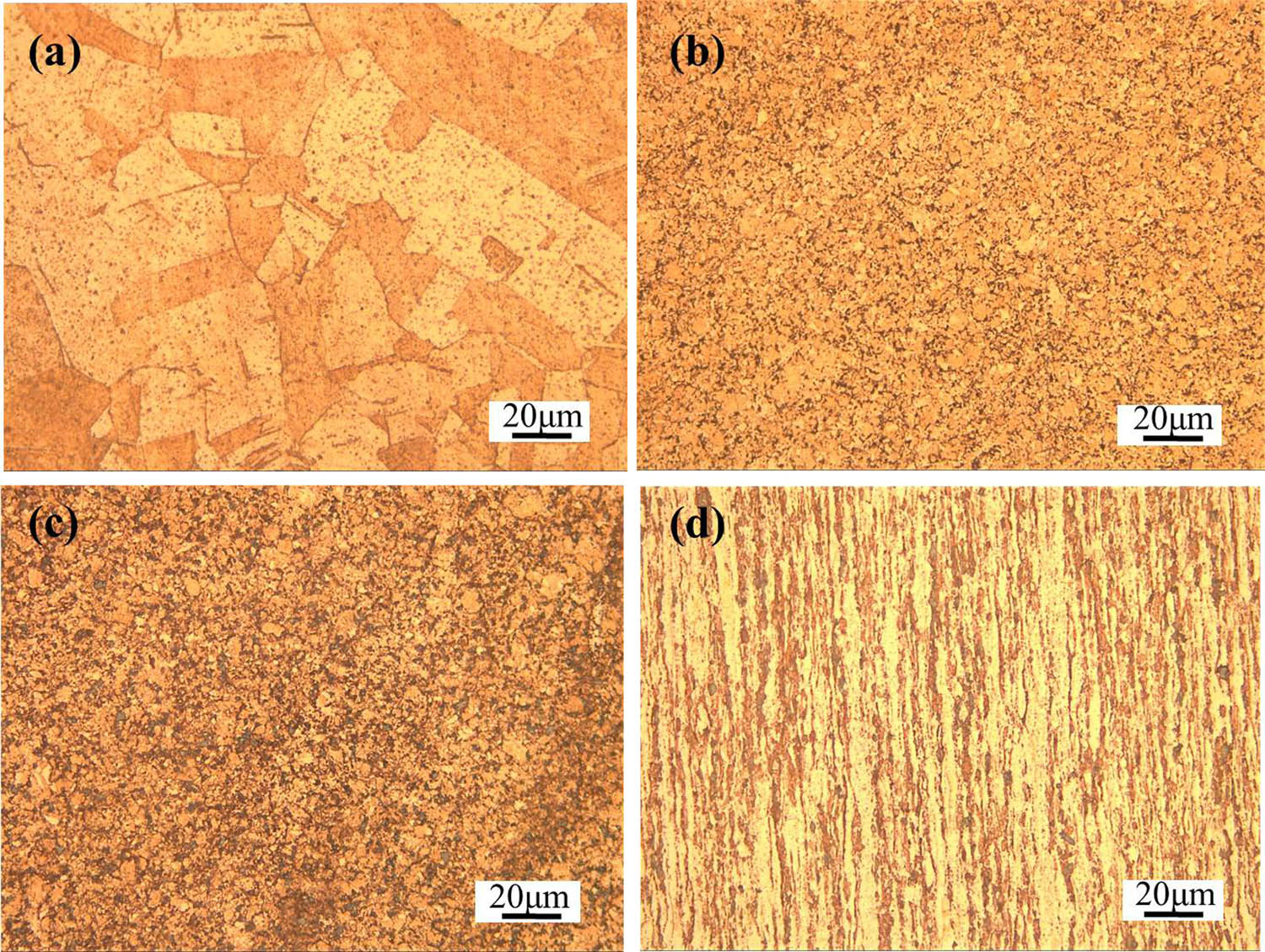
Microstructure of pure copper and its composites: (a) pure copper, (b) Cu–Al2O3, (c) cross-sectional microstructure of SiCw/Cu–Al2O3, and (d) longitudinal-section microstructure of SiCw/Cu–Al2O3.
Figure 3 shows the high-resolution transmission electron microscopy (HR-TEM) images of the SiCw/Cu–Al2O3 composite. Figure 3a shows that γ-Al2O3 particles with a particle size of 3–8 nm are uniformly dispersed in the copper matrix, with an average particle spacing of 50 nm. Fine nano-Al2O3 particles are more conducive to pinning dislocations, hindering dislocation movement and grain boundary slip and thus improving the strength of composites [21]. Figure 3b is an Inverse Fast Fourier Transform (IFFT) image of the area in the yellow dotted box in Figure 3a. The interface between γ-Al2O3 and the copper matrix is flat, and there are no physical gaps at the interface and no compounds produced by adverse reactions. The HR-TEM image of the interface between SiCw and the copper matrix in Figure 3d shows that there is an obvious amorphous transition layer at the interface between the copper matrix and SiCw. This is because Si atoms in SiC diffuse into the copper matrix, leaving only a layer of carbon at the interface between the copper matrix and SiCw [22]. This can also be proven by the existence of an amorphous diffuse scattering halo in the FFT diagram in the lower-left corner of Figure 3d. Meanwhile, the SAD pattern in the upper right corner Figure 3d shows the SiC diffraction spots, proving that the whiskers used are β-SiC. Compared with α-SiC, β-SiC has better hardness, tensile strength, elastic modulus, and high-temperature resistance, which is more conducive to improve the tensile strength of composites [23]. It is generally believed that the rough or bamboo-like surface of whiskers can increase the friction between whiskers and the matrix, thus improving the interfacial bonding strength [24]. Excessive interfacial strength leads to the fracture of whiskers and copper matrix composites during stretching, which limits the contribution of the whisker pull-out effect to the toughness of copper matrix composites [25]. The amorphous ribbon transition layer formed at the interface between the copper matrix and SiCw can reduce the interfacial bonding strength, reduce the shear stress that needs to be overcome when whiskers are pulled out, facilitate whisker pulling out, and play an obvious role in improving the tensile strength and toughness of the composite [26].
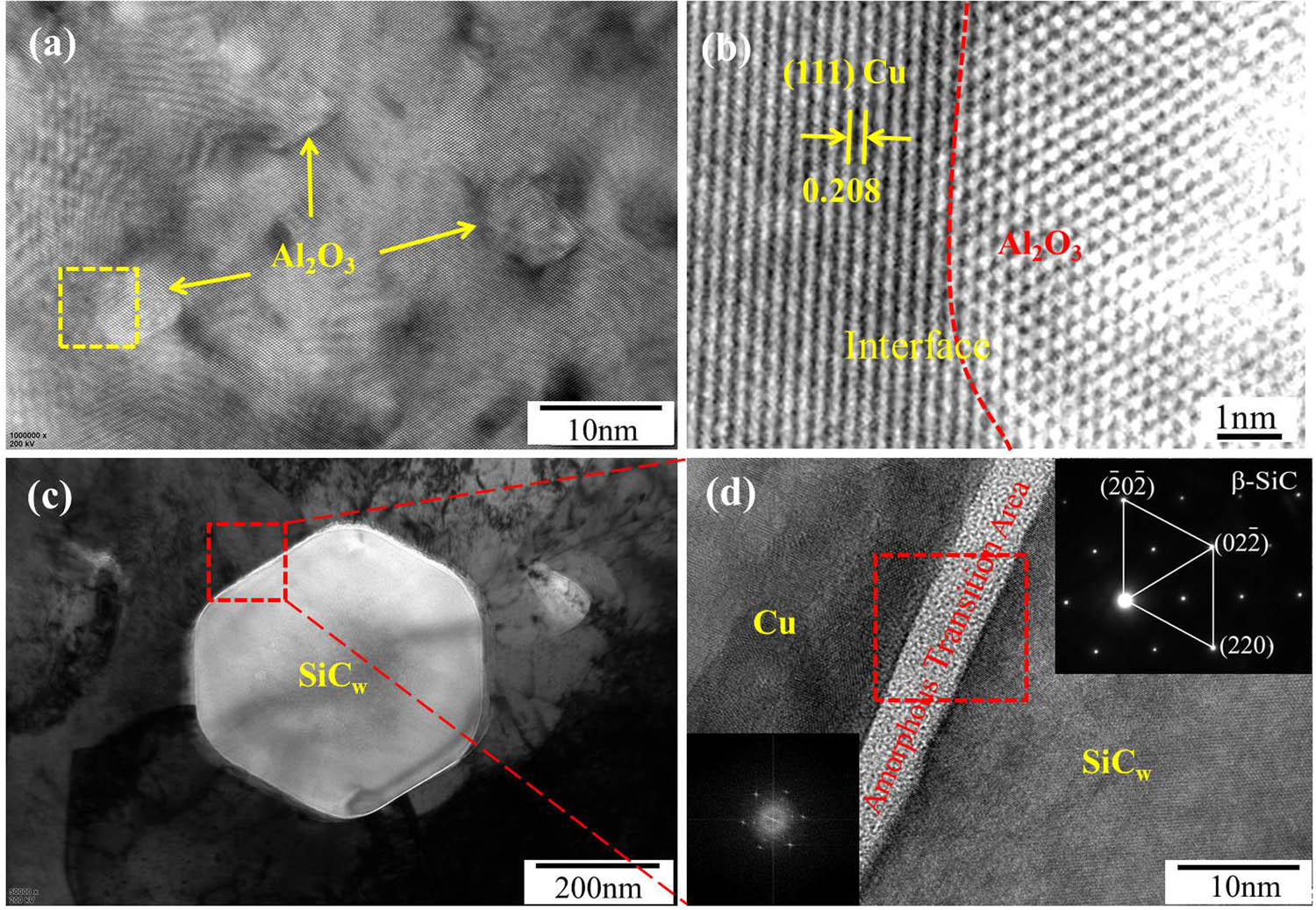
TEM images of the SiCw/Cu–Al2O3 composite: (a) HR-TEM image of nano-Al2O3 particles, (b) IFFT image of the boxed area in (a), (c) TEM cross-sectional image of SiCw, and (d) HR-TEM image of the boxed area in (c).
3.2 Mechanical properties and fracture morphology of the SiCw/Cu–Al2O3 composite
Figure 4 shows the engineering tensile stress–strain curves of pure copper and its composites. In summary, compared with pure copper, the strength of the SiCw/Cu composite is not greatly improved by adding a single reinforcing phase of SiCw, but the tensile strength of the SiCw/Cu–Al2O3 composite is greatly improved. The addition of the reinforcing phase inevitably led to a decrease in the ductility of the composites [27]. The ultimate tensile strength of pure copper is 228.4 MPa, and the elongation is 50.4%. The ultimate tensile strength of the Cu–Al2O3 composite is 471.5 MPa, and the elongation is 15.4%. The elongation of the Cu–Al2O3 composite decreased due to uncoordinated deformation between hard Al2O3 particles and the copper matrix, with good plasticity during deformation, which indicated that the tensile strength of the composites increased at the expense of elongation [28]. The ultimate tensile strength of the SiCw/Cu composite is 246.5 MPa, which is not greatly improved compared with that of pure copper, and its elongation is poor, which may be caused by SiCw agglomeration. The ultimate tensile strength of the SiCw/Cu–Al2O3 composite is 508.9 MPa, and the elongation is 8.5%. Compared with that of the Cu–Al2O3 and SiCw/Cu composites, the tensile strength of the SiCw/Cu–Al2O3 composite is increased by 7.9 and 51.6%, respectively. The further improvement in tensile strength indicates that the effect of the hybrid reinforcement of SiCw and nano-Al2O3 particles is better than that of the composite reinforced by SiCw or nano-Al2O3 particles alone. Hybrid reinforcement can improve the spatial configuration of each reinforcing phase, which is beneficial to fully exploiting the advantages of SiCw and nano-Al2O3 particles and then improve the strength of copper matrix composites [29].
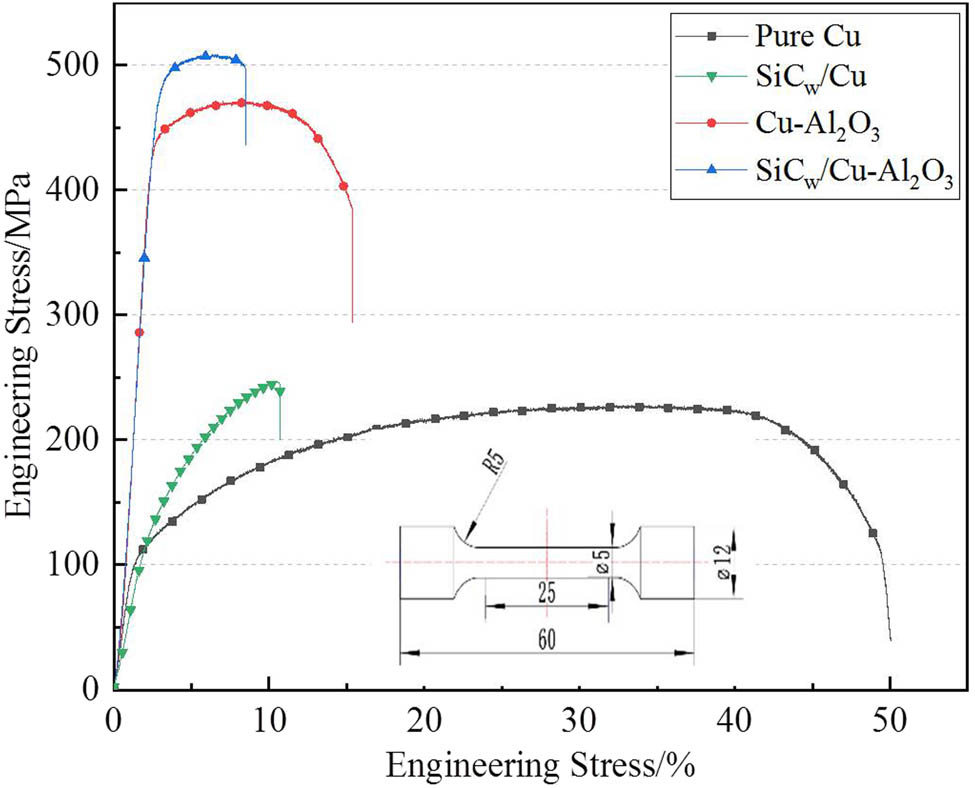
Engineering tensile stress–strain curves of pure copper and composites.
Figure 5 shows the tensile fracture morphology of pure copper and copper matrix composites. The pure copper sample has obvious plastic deformation before fracture, the fracture surface is mainly composed of large and deep dimples and torn edges, and the fracture surface is characterized by a typical micropore aggregation fracture surface, as shown in Figure 5a. Compared with the fracture morphology of pure copper, the dimples of the Cu–Al2O3 composite become smaller and shallower, which worsens the plasticity of the composite (Figure 5b). Figure 5c shows the fracture morphology of the SiCw/Cu composite, and there is a large amount of agglomerated SiCw at the fracture. Agglomerated SiCw cannot effectively contact the copper matrix, which reduces the interfacial bonding strength and makes it easier to fall off under the action of an external force, resulting in the lower strength of the SiCw/Cu composite [30]. The fracture morphology of the SiCw/Cu–Al2O3 composite (Figure 5d) shows that the axial direction of SiCw is the same as the tensile direction, which hinders grain boundary slip, and there are “SiCw bridges” and SiCw pulling out at the crack. The bridging effect of SiCw can hinder crack propagation and promote crack deflection. Nano-Al2O3 particles can inhibit grain growth and promote crack deflection, which is conducive to improve the strength of composites, and dispersed nano-Al2O3 particles are beneficial to improve the plasticity of materials [31].
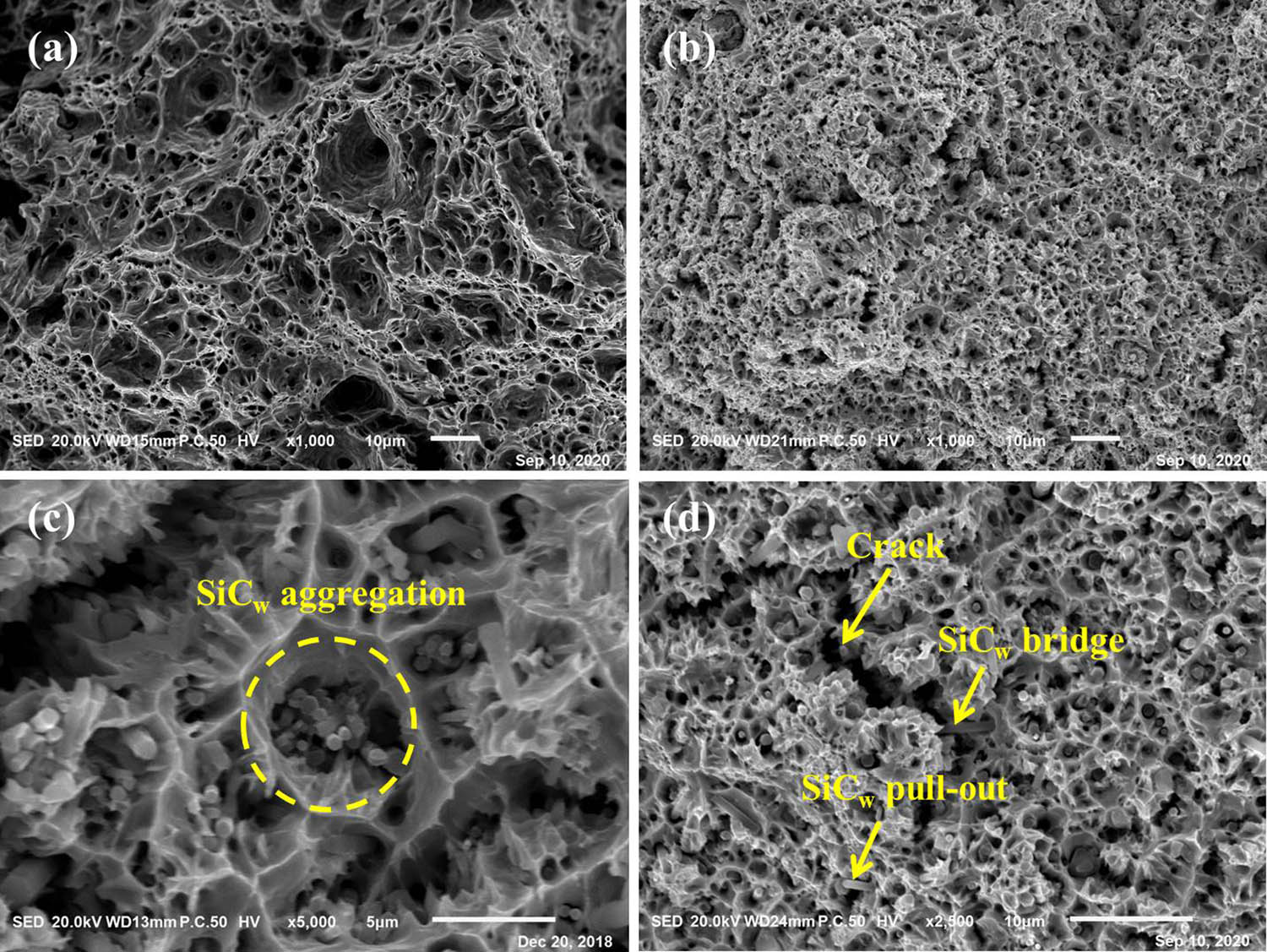
Tensile fracture morphology of copper matrix composites: (a) Pure copper, (b) Cu–Al2O3, (c) SiCw/Cu, and (d) SiCw/Cu–Al2O3.
3.3 Analysis of strengthening mechanism of the SiCw/Cu–Al2O3 composite
There are many strengthening mechanisms in composites, such as grain refinement (GR) [32], Orowan strengthening (OS) [33], load transfer (LT) [34], and thermal mismatch (TM) [35]. Due to the different thermal expansion coefficients of the reinforcing phase and copper matrix, thermal mismatch strengthening occurs in the cooling process of the composite material, but the samples will play a considerable role in thermal mismatch strengthening only during rapid cooling [36]. As the cooling process of this test is furnace cooling or slow cooling, the contribution of thermal mismatch strengthening to the strength of materials is temporarily ignored. Therefore, the strength contribution of the SiCw/Cu–Al2O3 composite mainly comes from grain refinement, Orowan strengthening, and load transfer strengthening.
3.3.1 Orowan strengthening
Research shows that long whiskers with large aspect ratios cannot be effectively surrounded by dislocation loops [37]. Therefore, the contribution of Orowan strengthening to the strength of the SiCw/Cu–Al2O3 composite mainly comes from dispersed nano-Al2O3 particles. Dislocation lines cannot cut through hard Al2O3 particles directly, but bend gradually under the action of external stress until the dislocation lines at both ends meet to form a closed dislocation loop, and the remaining dislocation lines continue to move forward under the action of external force. The Orowan strengthening equation is as follows [38]:
where G is the shear modulus (42.1 GPa for Cu [39]), v is the Poisson’s ratio (0.326 for Cu [39]), b is the Burger’s vector (0.256 nm for Cu [39]), L is the particle spacing, and D is the average particle size. According to the calculation, the contribution of the Orowan strengthening mechanism to the strength of the SiCw/Cu–Al2O3 composite is 145.2 MPa. Equation (1) shows that the smaller the distance between particles is the greater the critical shear stress required for dislocation motion. Dislocation loops around particles also hinder the movement of dislocation sources and other dislocations, and further strengthen the copper matrix.
3.3.2 Grain refinement
Figure 2b and c show that the addition of SiCw and nano-Al2O3 particles can obviously refine the grains. Theoretically, SiCw also hinders the movement of grain boundaries, but in this experiment, the addition of silicon carbide whiskers has little effect on grain size, and nano-Al2O3 particles play a major role in grain refinement. To further determine the influence of nano-Al2O3 particles and SiCw on grain size, EBSD analysis was carried out, as shown in Figure 6. The movement of nano-Al2O3 particles on the grain boundary of the copper matrix produces Zener resistance, inhibits grain growth, and produces Hall-patch fine grain strengthening, according to the following equation [38]:
where k is a constant (Cu = 0.07 MPa × m 0.5 [40]), d c is the grain size of the SiCw/Cu–Al2O3 composite (d c = 1.43 μm), and d m is the average size of pure Cu. The σ GR value provided by nano-Al2O3 particles was calculated to be 35.6 MPa.
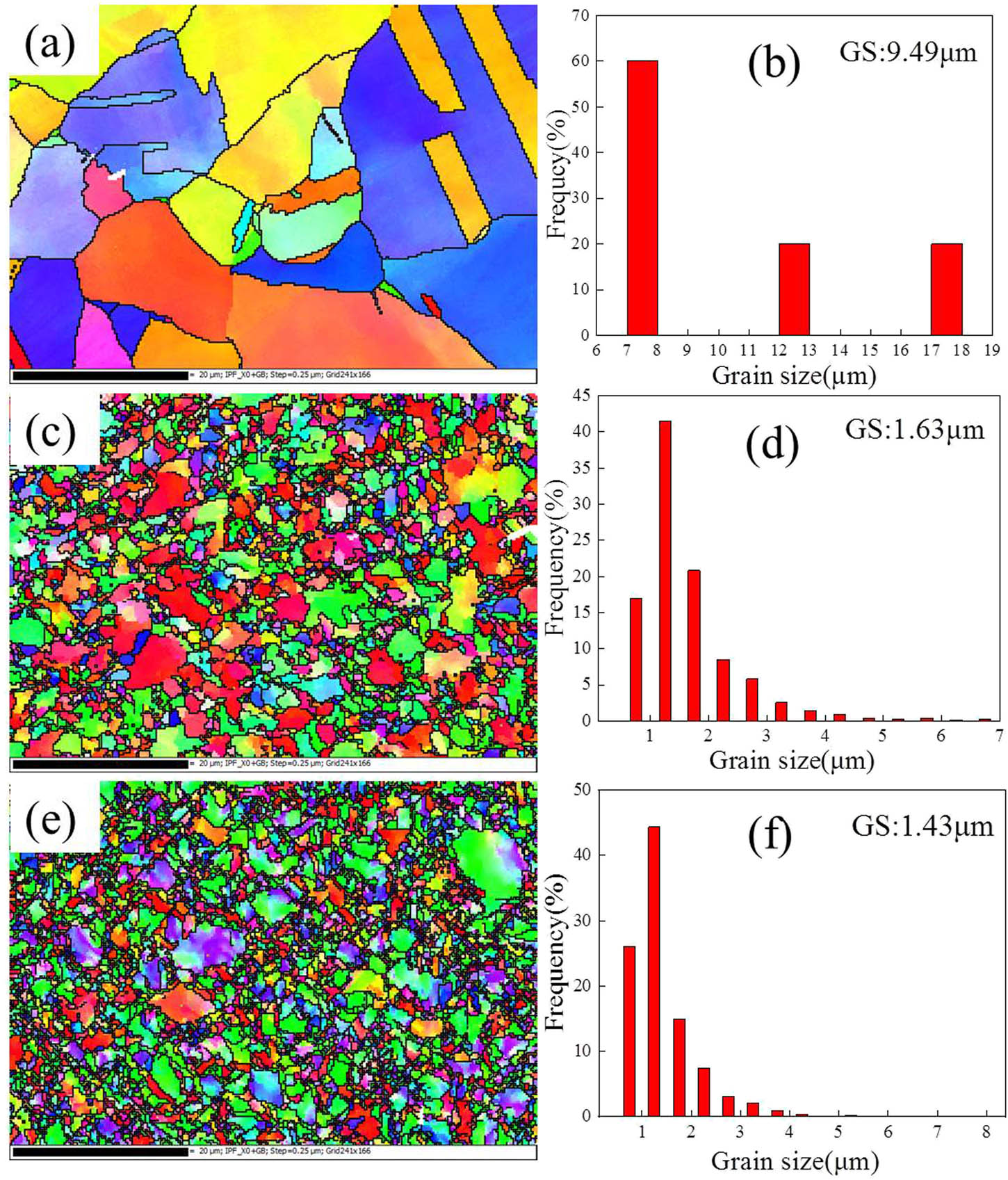
EBSD map (IPF) and grain size distributions of copper matrix composites: (a and b) pure Cu, (c and d) Cu–Al2O3, and (e and f) SiCw/Cu–Al2O3.
3.3.3 Load transfer
When the load is fully applied and the whiskers arranged along the tensile direction are evenly distributed in the copper matrix, load transfer strengthening can be effectively realized [41]. Whiskers or short fibers are pulled out and broken during stretching. When the length is less than a certain critical length will be drawn out. When the length of SiCw is less than a certain critical length l c, the whiskers or short fibers will be pulled out; otherwise, it will break. The critical length can be obtained according to the equilibrium condition of force [42]:
where
where
3.3.4 Synergistic strengthening
The total contribution of various strengthening mechanisms in the Cu–Al2O3 composite is 370.9 MPa, which is 68.8 MPa less than the actual tensile yield strength (439.7 MPa). The total contribution of various strengthening mechanisms in the SiCw/Cu–Al2O3 composite is 442 MPa, which is 33.9 MPa less than the actual tensile yield strength (475.9 MPa). Therefore, it can be inferred that the addition of SiCw reduces the difference between the calculated and experimental values of single-reinforced composite (Cu–Al2O3) and double-reinforced composite (SiCw/Cu–Al2O3), and nano-Al2O3 particles play a positive role in enhancing the load transfer of SiCw. Liu et al. [43] studied the strengthening mechanism when SiCw and nanoparticles were added alone or in combination and found that the combination of SiCw and nanoparticles can change the microstructure of materials, and thus the mechanical properties of composites. Particle-whisker hybrid-reinforced copper matrix composites exert the advantages of each reinforced phase, and at the same time, each component synergistically strengthens copper matrix composites [37]. As seen in Figure 5c, agglomerated SiCw can be seen in the fracture morphology of the SiCw/Cu composite, but there is no large area of agglomerated SiCw in the fracture morphology of the SiCw/Cu–Al2O3 composite in Figure 5d. The synergistic effect is that nano-Al2O3 particles can adjust the spatial distribution of SiCw in the copper matrix and reduce the agglomeration of SiCw. With the addition of SiCw, the distribution of nano-Al2O3 particles is more uniform, and the spatial configuration is better, as shown in Figure 7. The contact area between dispersed SiCw and the copper matrix increases, which is beneficial for improving the interfacial bonding strength and reducing the shedding phenomenon caused by the agglomeration of SiCw during stretching. Nano-Al2O3 particles further restrict the shedding and pulling-off of SiCw and further improve the tensile strength of the SiCw/Cu–Al2O3 composite. The above results show that SiCw and nano-Al2O3 particles have synergistic effects on strengthening copper matrix composites. The difference between the calculated value and the experimental value can be regarded as the contribution value of thermal mismatch and synergistic strengthening mechanism to the strength of the SiCw/Cu–Al2O3 composite, and the contribution ratio to the strength is 7.1%.
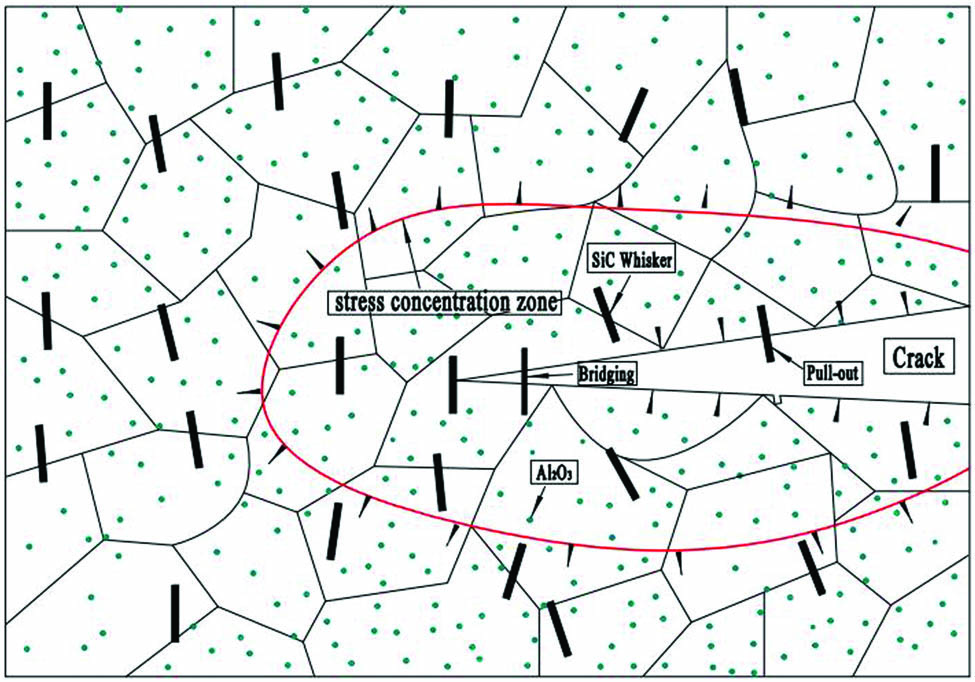
Schematic diagram of the particle and whisker hybrid-reinforced SiCw/Cu–Al2O3 composite.
3.4 Arc erosion resistance of the SiCw/Cu–Al2O3 composite
The distributions of arc duration and arc energy data of Cu–Al2O3 composite and SiCw/Cu–Al2O3 composite are shown in Figure 8a and b. Arc duration and arc energy have the same fluctuation tendency. The electrical contact test of the Cu–Al2O3 composite cannot be continued after 1,500 operations due to the serious oxidation of the contact surface. The SiCw/Cu–Al2O3 composite has good arc stability in the first 2,700 operation times, and the arc duration and arc energy increase sharply in the later stage, but 5,000 operations have been successfully completed. Comparing the arc duration and arc energy of the first 1,500 operation times, it is found that the average arc duration and arc energy of the SiCw/Cu–Al2O3 composite are lower than that of the Cu–Al2O3 composite, and the SiCw/Cu–Al2O3 composite has a better arc stability. Therefore, the addition of SiCw has a more significant effect on reducing the arc duration and energy of the Cu–Al2O3 composite.
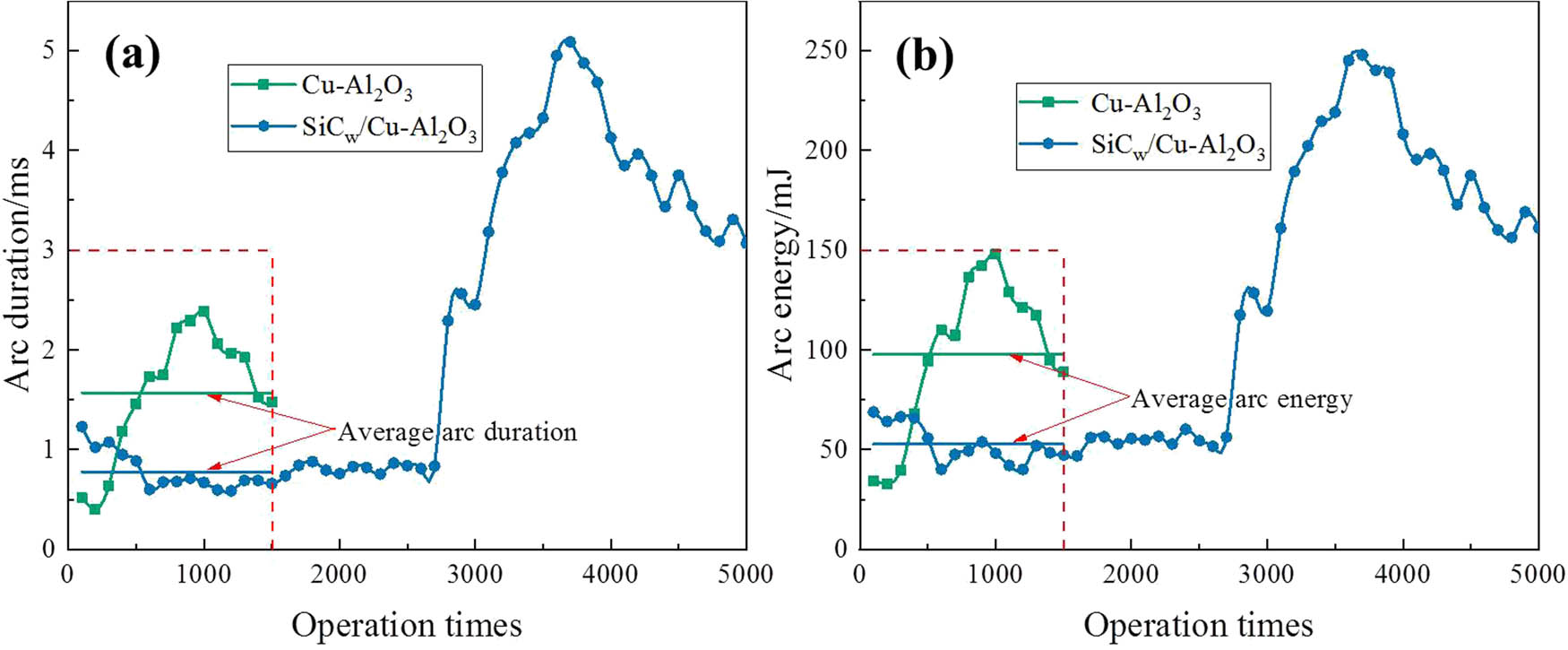
Fluctuation distribution curves of arc duration (a) and arc energy (b).
Figure 9 shows the surface morphologies of anode and cathode contact materials after arc erosion. Compared with the erosion morphologies of the SiC/Cu–Al2O3 composite, the erosion area of the Cu–Al2O3 composite is larger. It is found that a large number of molten droplets adhere to the contact surface, which seriously damages the connectivity of the circuit and leads to the failure of the Cu–Al2O3 contact pairs. The electrical contact experiment shows that the arc erosion resistance of the Cu–Al2O3 composite is far less than that of the SiCw/Cu–Al2O3 composite.
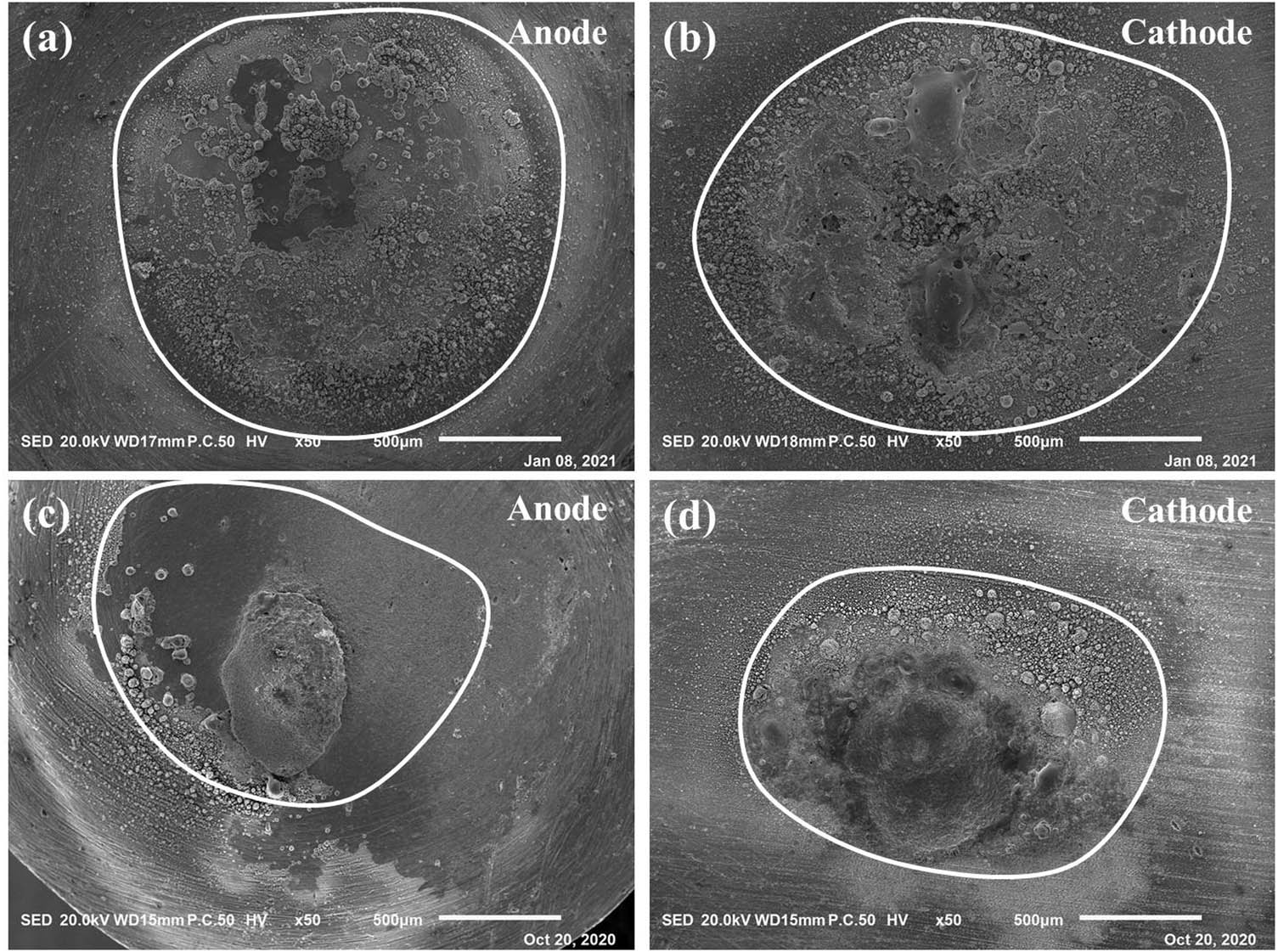
Erosion morphologies of anode and cathode for the Cu–Al2O3 composite (a and b) and the SiCw/Cu–Al2O3 composite (c and d).
4 Conclusions
Nano-Al2O3 particles and SiCw can adjust the spatial distribution of each other in the copper matrix, which is more conducive to fully exploiting the advantages of each reinforcing phase. The introduction of high-strength SiCw can bridge the copper matrix, promote crack deflection, and further improve the tensile strength of copper matrix composites.
Nano-Al2O3 particles and micro-SiCw reinforcements synergistically strengthened the SiCw/Cu–Al2O3 composite. Orowan strengthening is the main strengthening mechanism in the SiCw/Cu–Al2O3 composite, accounting for 30.5%.
The addition of SiC whiskers can improve the arc erosion resistance of the Cu–Al2O3 composite. Compared with the Cu–Al2O3 composite, the average arc duration and arc energy of the SiCw/Cu–Al2O3 composite were lower, and the arc stability was better.
-
Funding information: This work was supported by the project of the National Natural Science Foundation of China (51605146, U1502274), Henan Provincial Key Young Teachers Training Program for Higher Education Institutions (2018GGJS045), China Postdoctoral Science Foundation (2020T130172, 2020M682288), Henan Province “Innovative Science and Technology Team” Program (182101510003), and the Key Scientific Research Projects of Higher Education Institutions in Henan Province (21A430014).
-
Author contributions: All authors have accepted responsibility for the entire content of this manuscript and approved its submission.
-
Conflict of interest: The authors state no conflict of interest.
References
[1] Feng J, Song KX, Liang SH, Guo XH, Jiang YH. Electrical wear of TiB2 particle-reinforced Cu and Cu–Cr composites prepared by vacuum arc melting. Vacuum. 2020;175:92–5.10.1016/j.vacuum.2020.109295Search in Google Scholar
[2] Ma GZ, Xu BS, Wang HD, Wang XH, Zhang S. Research on the microstructure and space tribology properties of electric-brush plated Ni/MoS2-C composite coating. Surf Coat Technol. 2013;221:142–9.10.1016/j.surfcoat.2013.01.039Search in Google Scholar
[3] Shankar U, Naduvinamani NB, Basha H. A generalized perspective of fourier and fick’s laws: magnetized effects of Cattaneo-Christov models on transient nanofluid flow between two parallel plates with brownian motion and thermophoresis. Nonlinear Eng. 2020;9(1):201–22.10.1515/nleng-2020-0009Search in Google Scholar
[4] Jiang YH, Zhang XJ, Zhang XN, Lan T, Cao F, Liang SH. Structural heterogeneity and its effects on the properties of an in situ TiB2–TiC/Cu composite synthesised by hot pressing. Powder Metall. 2020;63(2):126–33.10.1080/00325899.2020.1746509Search in Google Scholar
[5] Liang SH, Li WZ, Jiang YH, Cao F, Dong GZ, Xiao P. Microstructures and properties of hybrid copper matrix composites reinforced by TiB whiskers and TiB2 particles. J Alloys Compd. 2019;797:589–94.10.1016/j.jallcom.2019.05.129Search in Google Scholar
[6] Chen SH, Fu SL, Liang D, Chen XH, Mi XJ, Liu P, et al. Preparation and properties of 3D interconnected CNTs/Cu composites. Nanotechnol Rev. 2020;9(1):146–54.10.1515/ntrev-2020-0013Search in Google Scholar
[7] Zhu SX, Liu Y, Tian BH, Zhang Y, Song KX. Arc erosion behavior and mechanism of Cu/Cr20 electrical contact material. Vacuum. 2017;143:129–37.10.1016/j.vacuum.2017.06.002Search in Google Scholar
[8] Afifeh M, Hosseinipour SJ, Jamaati R. Nanostructured copper matrix composite with extraordinary strength and high electrical conductivity produced by asymmetric cryorolling. Mater Sci Eng A. 2019;763:138146.10.1016/j.msea.2019.138146Search in Google Scholar
[9] Hwang SJ. The formation kinetics of Cr2O3 dispersed Cu synthesized by Cryo-milling. Rev Adv Mater Sci. 2020;59(1):47–53.10.1515/rams-2020-0001Search in Google Scholar
[10] Zhang YF, Ji Z, Jia CC, Liu GM, Wan FR, Zhan Q. Influence of lanthanum on enhancement of mechanical and electrical properties of Cu–Al2O3 composites. J Rare Earth. 2019;37(5):534–40.10.1016/j.jre.2018.08.016Search in Google Scholar
[11] Pan Y, Xiao SQ, Lu X, Zhou C, Li Y, Liu ZW, et al. Fabrication, mechanical properties and electrical conductivity of Al2O3 reinforced Cu/CNTs composites. J Alloys Compd. 2019;782:1015–23.10.1016/j.jallcom.2018.12.222Search in Google Scholar
[12] Singh MK, Gautam RK. Synthesis of copper metal matrix hybrid composites using stir casting technique and its mechanical, optical and electrical behaviours. Trans Indian Inst Met. 2017;70(9):2415–28.10.1007/s12666-017-1103-0Search in Google Scholar
[13] Dang C, Liu HM, Feng S, Qu Y, Hu QL, Jiang JC. Effect of La2O3 addition on copper matrix composites reinforced with Al2O3 ceramic particles. Mater Res Express. 2019;6(10):106312.10.1088/2053-1591/ab3effSearch in Google Scholar
[14] Li SL, Guo XH, Zhang SL, Feng J, Song KX, Liang SH. Arc erosion behavior of TiB2/Cu composites with single-scale and dual-scale TiB2 particles. Nanotechnol Rev. 2019;8(1):619–27.10.1515/ntrev-2019-0054Search in Google Scholar
[15] Mani MK, Viola G, Reece MJ, Hall JP, Evans SL. Mechanical and magnetic characterisation of SiC whisker reinforced Fe-Co alloy composites. Mater Sci Eng A. 2014;592:19–27.10.1016/j.msea.2013.10.099Search in Google Scholar
[16] Dong RH, Yang WS, Wu P, Hussain M, Wu GH, Jiang LT. High content SiC nanowires reinforced Al composite with high strength and plasticity. Mater Sci Eng A. 2015;630:8–12.10.1016/j.msea.2015.02.013Search in Google Scholar
[17] Liu GM, Li B. Study on the electrical arc ablation performance of nano-SiCw reinforced Cu-matrix composites. Adv Mat Res. 2011;228–9:509–13.10.4028/www.scientific.net/AMR.228-229.509Search in Google Scholar
[18] Zhang WL, Ma X, Ding DY. Aging behavior and tensile response of a SiCw reinforced eutectoid zinc-aluminium-copper alloy matrix composite. J Alloys Compd. 2017;727:375–81.10.1016/j.jallcom.2017.08.130Search in Google Scholar
[19] Guo XH, Song KX, Liang SH, Wang X. Relationship between the MgOp/Cu interfacial bonding state and the arc erosion resistance of MgO/Cu composites. J Mater Res. 2017;32(19):3753–60.10.1557/jmr.2017.321Search in Google Scholar
[20] Song KX, Xing JD, Dong QM, Liu P, Tian BH, Cao XJ. Internal oxidation of dilute Cu–Al alloy powers with oxidant of Cu2O. Mater Sci Eng A. 2004;380(1–2):117–22.10.1016/j.msea.2004.03.042Search in Google Scholar
[21] Zhou DS, Geng HW, Zeng W, Zhang DL, Kong C, Munroe P. Suppressing Al2O3 nanoparticle coarsening and Cu nanograin growth of milled nanostructured Cu–5vol%Al2O3 composite powder particles by doping with Ti. J Mater Sci Technol. 2017;33(11):1323–8.10.1016/j.jmst.2017.03.010Search in Google Scholar
[22] An Z, Ohi A, Hirai M, Kusaka M, Iwami M. Study of the reaction at Cu/3C-SiC interface. Surf Sci. 2001;493(1):182–7.10.1016/S0039-6028(01)01211-0Search in Google Scholar
[23] Zhang XN, Geng L, Wang GS. Fabrication of Al-based hybrid composites reinforced with SiC whiskers and SiC nanoparticles by squeeze casting. J Mater Process Tech. 2006;176(1–3):146–51.10.1016/j.jmatprotec.2006.03.125Search in Google Scholar
[24] Pozuelo M, Kao WH, Yang JM. High-resolution TEM characterization of SiC nanowires as reinforcements in a nanocrystalline Mg-matrix. Mater Charact. 2013;77:81–8.10.1016/j.matchar.2013.01.003Search in Google Scholar
[25] Rajkovic V, Bozic D, Devecerski A, Jovanovic MT. Characteristic of copper matrix simultaneously reinforced with nano- and micro-sized Al2O3 particles. Mater Charact. 2012;67:129–37.10.1016/j.matchar.2012.02.022Search in Google Scholar
[26] Zhang XH, Xu L, Du SY, Han WB, Han JC, Liu CY. Thermal shock behavior of SiC-whisker-reinforced diboride ultrahigh-temperature ceramics. Scr Mater. 2008;59(1):55–8.10.1016/j.scriptamat.2008.02.023Search in Google Scholar
[27] Larionova T, Koltsova T, Fadin Y, Tolochko O. Friction and wear of copper-carbon nanofibers compact composites. Wear. 2014;319:118–22.10.1016/j.wear.2014.07.020Search in Google Scholar
[28] Guo XH, Song KX, Liang SH, Wang X, Zhang YM. Effect of Al2O3 particle size on electrical wear performance of Al2O3/Cu composites. Tribol T. 2016;59(1):170–7.10.1080/10402004.2015.1061079Search in Google Scholar
[29] Guo XH, Song KX, Wang X, Li GH, Zhang ZL. Effect of TiB2 particle size on the material transfer behaviour of Cu–TiB2 composites. Mater Sci Technol. 2020;36(15):1685–94.10.1080/02670836.2020.1821964Search in Google Scholar
[30] Li M, Chen FY, Si XY, Wang J, Du SY, Huang Q. Copper-SiC whiskers composites with interface optimized by Ti3SiC2. J Mater Sci. 2018;53(13):9806–15.10.1007/s10853-018-2255-ySearch in Google Scholar
[31] Ma K, Wen HM, Hu T, Topping TD, Isheim D, Seidman DN, et al. Mechanical behavior and strengthening mechanisms in ultrafine grain precipitation-strengthened aluminum alloy. Acta Mater. 2014;62:141–55.10.1016/j.actamat.2013.09.042Search in Google Scholar
[32] Cheng C, Song KX, Mi XJ, Wu BA, Xiao Z, Xie HF, et al. Microstructural evolution and properties of Cu–20 wt% Ag alloy wire by multi-pass continuous drawing. Nanotechnol Rev. 2020;9(1):1359–67.10.1515/ntrev-2020-0108Search in Google Scholar
[33] Rajkovic V, Bozic D, Stasic J, Wang HW, Jovanovic MT. Processing, characterization and properties of copper-based composites strengthened by low amount of alumina particles. Powder Technol. 2014;268:392–400.10.1016/j.powtec.2014.08.051Search in Google Scholar
[34] Chu K, Wang F, Li YB, Wang XH, Huang DJ, Zhang H. Interface structure and strengthening behavior of graphene/CuCr composites. Carbon. 2018;133:127–39.10.1016/j.carbon.2018.03.018Search in Google Scholar
[35] Wu Q, Miao WS, Zhang YD, Gao HJ, David H. Mechanical properties of nanomaterials: a review. Nanotechnol Rev. 2020;9(1):259–73.10.1515/ntrev-2020-0021Search in Google Scholar
[36] George R, Kashyap KT, Rahul R, Yamdagni S. Strengthening in carbon nanotube/aluminium (CNT/Al) composites. Scr Mater. 2005;53(10):1159–63.10.1016/j.scriptamat.2005.07.022Search in Google Scholar
[37] Long F, Guo XH, Song KX, Jia SG, Yakubovd V, Li SL, et al. Synergistic strengthening effect of carbon nanotubes (CNTs) and titanium diboride (TiB2) microparticles on mechanical properties of copper matrix composites. J Mater Res Technol. 2020;9(4):7989–8000.10.1016/j.jmrt.2020.05.036Search in Google Scholar
[38] Queyreau S, Monnet G, Devincre B. Orowan strengthening and forest hardening superposition examined by dislocation dynamics simulations. Acta Mater. 2010;58(17):5586–95.10.1016/j.actamat.2010.06.028Search in Google Scholar
[39] Wang XL, Wang YP, Su Y, Qu ZG. Synergetic strengthening effects on copper matrix induced by Al2O3 particle revealed from micro-scale mechanical deformation and microstructure evolutions. Ceram Int. 2019;45(12):14889–95.10.1016/j.ceramint.2019.04.222Search in Google Scholar
[40] Chen XF, Tao JM, Yi JH, Liu YC, Li CJ, Bao R. Strengthening behavior of carbon nanotube-graphene hybrids in copper matrix composites. Mater Sci Eng A. 2018;718:427–36.10.1016/j.msea.2018.02.006Search in Google Scholar
[41] Chen B, Li SF, Imai H, Jia L, Umeda J, Takahashi M, et al. Load transfer strengthening in carbon nanotubes reinforced metal matrix composites via in-situ tensile tests. Compos Sci Technol. 2015;113:1–8.10.1016/j.compscitech.2015.03.009Search in Google Scholar
[42] Chen B, Shen J, Ye X, Imai H, Umeda J, Takahashi M, et al. Solid-state interfacial reaction and load transfer efficiency in carbon nanotubes (CNTs)-reinforced aluminum matrix composites. Carbon. 2017;114:198–208.10.1016/j.carbon.2016.12.013Search in Google Scholar
[43] Liu XF, Liu HL, Huang CZ, Wang LM, Zou B, Zhao B. Synergistically toughening effect of SiC whiskers and nanoparticles in Al2O3-based composite ceramic cutting tool material. Chin J Mech Eng. 2016;29(5):977–82.10.3901/CJME.2016.0411.049Search in Google Scholar
© 2021 Huanran Lin et al., published by De Gruyter
This work is licensed under the Creative Commons Attribution 4.0 International License.
Articles in the same Issue
- Research Articles
- Improved impedance matching by multi-componential metal-hybridized rGO toward high performance of microwave absorption
- Pure-silk fibroin hydrogel with stable aligned micropattern toward peripheral nerve regeneration
- Effective ion pathways and 3D conductive carbon networks in bentonite host enable stable and high-rate lithium–sulfur batteries
- Fabrication and characterization of 3D-printed gellan gum/starch composite scaffold for Schwann cells growth
- Synergistic strengthening mechanism of copper matrix composite reinforced with nano-Al2O3 particles and micro-SiC whiskers
- Deformation mechanisms and plasticity of ultrafine-grained Al under complex stress state revealed by digital image correlation technique
- On the deformation-induced grain rotations in gradient nano-grained copper based on molecular dynamics simulations
- Removal of sulfate from aqueous solution using Mg–Al nano-layered double hydroxides synthesized under different dual solvent systems
- Microwave-assisted sol–gel synthesis of TiO2-mixed metal oxide nanocatalyst for degradation of organic pollutant
- Electrophoretic deposition of graphene on basalt fiber for composite applications
- Polyphenylene sulfide-coated wrench composites by nanopinning effect
- Thermal conductivity and thermoelectric properties in 3D macroscopic pure carbon nanotube materials
- An effective thermal conductivity and thermomechanical homogenization scheme for a multiscale Nb3Sn filaments
- Friction stir spot welding of AA5052 with additional carbon fiber-reinforced polymer composite interlayer
- Improvement of long-term cycling performance of high-nickel cathode materials by ZnO coating
- Quantum effects of gas flow in nanochannels
- An approach to effectively improve the interfacial bonding of nano-perfused composites by in situ growth of CNTs
- Effects of nano-modified polymer cement-based materials on the bending behavior of repaired concrete beams
- Effects of the combined usage of nanomaterials and steel fibres on the workability, compressive strength, and microstructure of ultra-high performance concrete
- One-pot solvothermal synthesis and characterization of highly stable nickel nanoparticles
- Comparative study on mechanisms for improving mechanical properties and microstructure of cement paste modified by different types of nanomaterials
- Effect of in situ graphene-doped nano-CeO2 on microstructure and electrical contact properties of Cu30Cr10W contacts
- The experimental study of CFRP interlayer of dissimilar joint AA7075-T651/Ti-6Al-4V alloys by friction stir spot welding on mechanical and microstructural properties
- Vibration analysis of a sandwich cylindrical shell in hygrothermal environment
- Water barrier and mechanical properties of sugar palm crystalline nanocellulose reinforced thermoplastic sugar palm starch (TPS)/poly(lactic acid) (PLA) blend bionanocomposites
- Strong quadratic acousto-optic coupling in 1D multilayer phoxonic crystal cavity
- Three-dimensional shape analysis of peripapillary retinal pigment epithelium-basement membrane layer based on OCT radial images
- Solvent regulation synthesis of single-component white emission carbon quantum dots for white light-emitting diodes
- Xanthate-modified nanoTiO2 as a novel vulcanization accelerator enhancing mechanical and antibacterial properties of natural rubber
- Effect of steel fiber on impact resistance and durability of concrete containing nano-SiO2
- Ultrasound-enhanced biosynthesis of uniform ZnO nanorice using Swietenia macrophylla seed extract and its in vitro anticancer activity
- Temperature dependence of hardness prediction for high-temperature structural ceramics and their composites
- Study on the frequency of acoustic emission signal during crystal growth of salicylic acid
- Controllable modification of helical carbon nanotubes for high-performance microwave absorption
- Role of dry ozonization of basalt fibers on interfacial properties and fracture toughness of epoxy matrix composites
- Nanosystem’s density functional theory study of the chlorine adsorption on the Fe(100) surface
- A rapid nanobiosensing platform based on herceptin-conjugated graphene for ultrasensitive detection of circulating tumor cells in early breast cancer
- Improving flexural strength of UHPC with sustainably synthesized graphene oxide
- The role of graphene/graphene oxide in cement hydration
- Structural characterization of microcrystalline and nanocrystalline cellulose from Ananas comosus L. leaves: Cytocompatibility and molecular docking studies
- Evaluation of the nanostructure of calcium silicate hydrate based on atomic force microscopy-infrared spectroscopy experiments
- Combined effects of nano-silica and silica fume on the mechanical behavior of recycled aggregate concrete
- Safety study of malapposition of the bio-corrodible nitrided iron stent in vivo
- Triethanolamine interface modification of crystallized ZnO nanospheres enabling fast photocatalytic hazard-free treatment of Cr(vi) ions
- Novel electrodes for precise and accurate droplet dispensing and splitting in digital microfluidics
- Construction of Chi(Zn/BMP2)/HA composite coating on AZ31B magnesium alloy surface to improve the corrosion resistance and biocompatibility
- Experimental and multiscale numerical investigations on low-velocity impact responses of syntactic foam composites reinforced with modified MWCNTs
- Comprehensive performance analysis and optimal design of smart light pole for cooperative vehicle infrastructure system
- Room temperature growth of ZnO with highly active exposed facets for photocatalytic application
- Influences of poling temperature and elongation ratio on PVDF-HFP piezoelectric films
- Large strain hardening of magnesium containing in situ nanoparticles
- Super stable water-based magnetic fluid as a dual-mode contrast agent
- Photocatalytic activity of biogenic zinc oxide nanoparticles: In vitro antimicrobial, biocompatibility, and molecular docking studies
- Hygrothermal environment effect on the critical buckling load of FGP microbeams with initial curvature integrated by CNT-reinforced skins considering the influence of thickness stretching
- Thermal aging behavior characteristics of asphalt binder modified by nano-stabilizer based on DSR and AFM
- Building effective core/shell polymer nanoparticles for epoxy composite toughening based on Hansen solubility parameters
- Structural characterization and nanoscale strain field analysis of α/β interface layer of a near α titanium alloy
- Optimization of thermal and hydrophobic properties of GO-doped epoxy nanocomposite coatings
- The properties of nano-CaCO3/nano-ZnO/SBR composite-modified asphalt
- Three-dimensional metallic carbon allotropes with superhardness
- Physical stability and rheological behavior of Pickering emulsions stabilized by protein–polysaccharide hybrid nanoconjugates
- Optimization of volume fraction and microstructure evolution during thermal deformation of nano-SiCp/Al–7Si composites
- Phase analysis and corrosion behavior of brazing Cu/Al dissimilar metal joint with BAl88Si filler metal
- High-efficiency nano polishing of steel materials
- On the rheological properties of multi-walled carbon nano-polyvinylpyrrolidone/silicon-based shear thickening fluid
- Fabrication of Ag/ZnO hollow nanospheres and cubic TiO2/ZnO heterojunction photocatalysts for RhB degradation
- Fabrication and properties of PLA/nano-HA composite scaffolds with balanced mechanical properties and biological functions for bone tissue engineering application
- Investigation of the early-age performance and microstructure of nano-C–S–H blended cement-based materials
- Reduced graphene oxide coating on basalt fabric using electrophoretic deposition and its role in the mechanical and tribological performance of epoxy/basalt fiber composites
- Effect of nano-silica as cementitious materials-reducing admixtures on the workability, mechanical properties and durability of concrete
- Machine-learning-assisted microstructure–property linkages of carbon nanotube-reinforced aluminum matrix nanocomposites produced by laser powder bed fusion
- Physical, thermal, and mechanical properties of highly porous polylactic acid/cellulose nanofibre scaffolds prepared by salt leaching technique
- A comparative study on characterizations and synthesis of pure lead sulfide (PbS) and Ag-doped PbS for photovoltaic applications
- Clean preparation of washable antibacterial polyester fibers by high temperature and high pressure hydrothermal self-assembly
- Al 5251-based hybrid nanocomposite by FSP reinforced with graphene nanoplates and boron nitride nanoparticles: Microstructure, wear, and mechanical characterization
- Interlaminar fracture toughness properties of hybrid glass fiber-reinforced composite interlayered with carbon nanotube using electrospray deposition
- Microstructure and life prediction model of steel slag concrete under freezing-thawing environment
- Synthesis of biogenic silver nanoparticles from the seed coat waste of pistachio (Pistacia vera) and their effect on the growth of eggplant
- Study on adaptability of rheological index of nano-PUA-modified asphalt based on geometric parameters of parallel plate
- Preparation and adsorption properties of nano-graphene oxide/tourmaline composites
- A study on interfacial behaviors of epoxy/graphene oxide derived from pitch-based graphite fibers
- Multiresponsive carboxylated graphene oxide-grafted aptamer as a multifunctional nanocarrier for targeted delivery of chemotherapeutics and bioactive compounds in cancer therapy
- Piezoresistive/piezoelectric intrinsic sensing properties of carbon nanotube cement-based smart composite and its electromechanical sensing mechanisms: A review
- Smart stimuli-responsive biofunctionalized niosomal nanocarriers for programmed release of bioactive compounds into cancer cells in vitro and in vivo
- Photoremediation of methylene blue by biosynthesized ZnO/Fe3O4 nanocomposites using Callistemon viminalis leaves aqueous extract: A comparative study
- Study of gold nanoparticles’ preparation through ultrasonic spray pyrolysis and lyophilisation for possible use as markers in LFIA tests
- Review Articles
- Advance on the dispersion treatment of graphene oxide and the graphene oxide modified cement-based materials
- Development of ionic liquid-based electroactive polymer composites using nanotechnology
- Nanostructured multifunctional electrocatalysts for efficient energy conversion systems: Recent perspectives
- Recent advances on the fabrication methods of nanocomposite yarn-based strain sensor
- Review on nanocomposites based on aerospace applications
- Overview of nanocellulose as additives in paper processing and paper products
- The frontiers of functionalized graphene-based nanocomposites as chemical sensors
- Material advancement in tissue-engineered nerve conduit
- Carbon nanostructure-based superhydrophobic surfaces and coatings
- Functionalized graphene-based nanocomposites for smart optoelectronic applications
- Interfacial technology for enhancement in steel fiber reinforced cementitious composite from nano to macroscale
- Metal nanoparticles and biomaterials: The multipronged approach for potential diabetic wound therapy
- Review on resistive switching mechanisms of bio-organic thin film for non-volatile memory application
- Nanotechnology-enabled biomedical engineering: Current trends, future scopes, and perspectives
- Research progress on key problems of nanomaterials-modified geopolymer concrete
- Smart stimuli-responsive nanocarriers for the cancer therapy – nanomedicine
- An overview of methods for production and detection of silver nanoparticles, with emphasis on their fate and toxicological effects on human, soil, and aquatic environment
- Effects of chemical modification and nanotechnology on wood properties
- Mechanisms, influencing factors, and applications of electrohydrodynamic jet printing
- Application of antiviral materials in textiles: A review
- Phase transformation and strengthening mechanisms of nanostructured high-entropy alloys
- Research progress on individual effect of graphene oxide in cement-based materials and its synergistic effect with other nanomaterials
- Catalytic defense against fungal pathogens using nanozymes
- A mini-review of three-dimensional network topological structure nanocomposites: Preparation and mechanical properties
- Mechanical properties and structural health monitoring performance of carbon nanotube-modified FRP composites: A review
- Nano-scale delivery: A comprehensive review of nano-structured devices, preparative techniques, site-specificity designs, biomedical applications, commercial products, and references to safety, cellular uptake, and organ toxicity
- Effects of alloying, heat treatment and nanoreinforcement on mechanical properties and damping performances of Cu–Al-based alloys: A review
- Recent progress in the synthesis and applications of vertically aligned carbon nanotube materials
- Thermal conductivity and dynamic viscosity of mono and hybrid organic- and synthetic-based nanofluids: A critical review
- Recent advances in waste-recycled nanomaterials for biomedical applications: Waste-to-wealth
- Layup sequence and interfacial bonding of additively manufactured polymeric composite: A brief review
- Quantum dots synthetization and future prospect applications
- Approved and marketed nanoparticles for disease targeting and applications in COVID-19
- Strategies for improving rechargeable lithium-ion batteries: From active materials to CO2 emissions
Articles in the same Issue
- Research Articles
- Improved impedance matching by multi-componential metal-hybridized rGO toward high performance of microwave absorption
- Pure-silk fibroin hydrogel with stable aligned micropattern toward peripheral nerve regeneration
- Effective ion pathways and 3D conductive carbon networks in bentonite host enable stable and high-rate lithium–sulfur batteries
- Fabrication and characterization of 3D-printed gellan gum/starch composite scaffold for Schwann cells growth
- Synergistic strengthening mechanism of copper matrix composite reinforced with nano-Al2O3 particles and micro-SiC whiskers
- Deformation mechanisms and plasticity of ultrafine-grained Al under complex stress state revealed by digital image correlation technique
- On the deformation-induced grain rotations in gradient nano-grained copper based on molecular dynamics simulations
- Removal of sulfate from aqueous solution using Mg–Al nano-layered double hydroxides synthesized under different dual solvent systems
- Microwave-assisted sol–gel synthesis of TiO2-mixed metal oxide nanocatalyst for degradation of organic pollutant
- Electrophoretic deposition of graphene on basalt fiber for composite applications
- Polyphenylene sulfide-coated wrench composites by nanopinning effect
- Thermal conductivity and thermoelectric properties in 3D macroscopic pure carbon nanotube materials
- An effective thermal conductivity and thermomechanical homogenization scheme for a multiscale Nb3Sn filaments
- Friction stir spot welding of AA5052 with additional carbon fiber-reinforced polymer composite interlayer
- Improvement of long-term cycling performance of high-nickel cathode materials by ZnO coating
- Quantum effects of gas flow in nanochannels
- An approach to effectively improve the interfacial bonding of nano-perfused composites by in situ growth of CNTs
- Effects of nano-modified polymer cement-based materials on the bending behavior of repaired concrete beams
- Effects of the combined usage of nanomaterials and steel fibres on the workability, compressive strength, and microstructure of ultra-high performance concrete
- One-pot solvothermal synthesis and characterization of highly stable nickel nanoparticles
- Comparative study on mechanisms for improving mechanical properties and microstructure of cement paste modified by different types of nanomaterials
- Effect of in situ graphene-doped nano-CeO2 on microstructure and electrical contact properties of Cu30Cr10W contacts
- The experimental study of CFRP interlayer of dissimilar joint AA7075-T651/Ti-6Al-4V alloys by friction stir spot welding on mechanical and microstructural properties
- Vibration analysis of a sandwich cylindrical shell in hygrothermal environment
- Water barrier and mechanical properties of sugar palm crystalline nanocellulose reinforced thermoplastic sugar palm starch (TPS)/poly(lactic acid) (PLA) blend bionanocomposites
- Strong quadratic acousto-optic coupling in 1D multilayer phoxonic crystal cavity
- Three-dimensional shape analysis of peripapillary retinal pigment epithelium-basement membrane layer based on OCT radial images
- Solvent regulation synthesis of single-component white emission carbon quantum dots for white light-emitting diodes
- Xanthate-modified nanoTiO2 as a novel vulcanization accelerator enhancing mechanical and antibacterial properties of natural rubber
- Effect of steel fiber on impact resistance and durability of concrete containing nano-SiO2
- Ultrasound-enhanced biosynthesis of uniform ZnO nanorice using Swietenia macrophylla seed extract and its in vitro anticancer activity
- Temperature dependence of hardness prediction for high-temperature structural ceramics and their composites
- Study on the frequency of acoustic emission signal during crystal growth of salicylic acid
- Controllable modification of helical carbon nanotubes for high-performance microwave absorption
- Role of dry ozonization of basalt fibers on interfacial properties and fracture toughness of epoxy matrix composites
- Nanosystem’s density functional theory study of the chlorine adsorption on the Fe(100) surface
- A rapid nanobiosensing platform based on herceptin-conjugated graphene for ultrasensitive detection of circulating tumor cells in early breast cancer
- Improving flexural strength of UHPC with sustainably synthesized graphene oxide
- The role of graphene/graphene oxide in cement hydration
- Structural characterization of microcrystalline and nanocrystalline cellulose from Ananas comosus L. leaves: Cytocompatibility and molecular docking studies
- Evaluation of the nanostructure of calcium silicate hydrate based on atomic force microscopy-infrared spectroscopy experiments
- Combined effects of nano-silica and silica fume on the mechanical behavior of recycled aggregate concrete
- Safety study of malapposition of the bio-corrodible nitrided iron stent in vivo
- Triethanolamine interface modification of crystallized ZnO nanospheres enabling fast photocatalytic hazard-free treatment of Cr(vi) ions
- Novel electrodes for precise and accurate droplet dispensing and splitting in digital microfluidics
- Construction of Chi(Zn/BMP2)/HA composite coating on AZ31B magnesium alloy surface to improve the corrosion resistance and biocompatibility
- Experimental and multiscale numerical investigations on low-velocity impact responses of syntactic foam composites reinforced with modified MWCNTs
- Comprehensive performance analysis and optimal design of smart light pole for cooperative vehicle infrastructure system
- Room temperature growth of ZnO with highly active exposed facets for photocatalytic application
- Influences of poling temperature and elongation ratio on PVDF-HFP piezoelectric films
- Large strain hardening of magnesium containing in situ nanoparticles
- Super stable water-based magnetic fluid as a dual-mode contrast agent
- Photocatalytic activity of biogenic zinc oxide nanoparticles: In vitro antimicrobial, biocompatibility, and molecular docking studies
- Hygrothermal environment effect on the critical buckling load of FGP microbeams with initial curvature integrated by CNT-reinforced skins considering the influence of thickness stretching
- Thermal aging behavior characteristics of asphalt binder modified by nano-stabilizer based on DSR and AFM
- Building effective core/shell polymer nanoparticles for epoxy composite toughening based on Hansen solubility parameters
- Structural characterization and nanoscale strain field analysis of α/β interface layer of a near α titanium alloy
- Optimization of thermal and hydrophobic properties of GO-doped epoxy nanocomposite coatings
- The properties of nano-CaCO3/nano-ZnO/SBR composite-modified asphalt
- Three-dimensional metallic carbon allotropes with superhardness
- Physical stability and rheological behavior of Pickering emulsions stabilized by protein–polysaccharide hybrid nanoconjugates
- Optimization of volume fraction and microstructure evolution during thermal deformation of nano-SiCp/Al–7Si composites
- Phase analysis and corrosion behavior of brazing Cu/Al dissimilar metal joint with BAl88Si filler metal
- High-efficiency nano polishing of steel materials
- On the rheological properties of multi-walled carbon nano-polyvinylpyrrolidone/silicon-based shear thickening fluid
- Fabrication of Ag/ZnO hollow nanospheres and cubic TiO2/ZnO heterojunction photocatalysts for RhB degradation
- Fabrication and properties of PLA/nano-HA composite scaffolds with balanced mechanical properties and biological functions for bone tissue engineering application
- Investigation of the early-age performance and microstructure of nano-C–S–H blended cement-based materials
- Reduced graphene oxide coating on basalt fabric using electrophoretic deposition and its role in the mechanical and tribological performance of epoxy/basalt fiber composites
- Effect of nano-silica as cementitious materials-reducing admixtures on the workability, mechanical properties and durability of concrete
- Machine-learning-assisted microstructure–property linkages of carbon nanotube-reinforced aluminum matrix nanocomposites produced by laser powder bed fusion
- Physical, thermal, and mechanical properties of highly porous polylactic acid/cellulose nanofibre scaffolds prepared by salt leaching technique
- A comparative study on characterizations and synthesis of pure lead sulfide (PbS) and Ag-doped PbS for photovoltaic applications
- Clean preparation of washable antibacterial polyester fibers by high temperature and high pressure hydrothermal self-assembly
- Al 5251-based hybrid nanocomposite by FSP reinforced with graphene nanoplates and boron nitride nanoparticles: Microstructure, wear, and mechanical characterization
- Interlaminar fracture toughness properties of hybrid glass fiber-reinforced composite interlayered with carbon nanotube using electrospray deposition
- Microstructure and life prediction model of steel slag concrete under freezing-thawing environment
- Synthesis of biogenic silver nanoparticles from the seed coat waste of pistachio (Pistacia vera) and their effect on the growth of eggplant
- Study on adaptability of rheological index of nano-PUA-modified asphalt based on geometric parameters of parallel plate
- Preparation and adsorption properties of nano-graphene oxide/tourmaline composites
- A study on interfacial behaviors of epoxy/graphene oxide derived from pitch-based graphite fibers
- Multiresponsive carboxylated graphene oxide-grafted aptamer as a multifunctional nanocarrier for targeted delivery of chemotherapeutics and bioactive compounds in cancer therapy
- Piezoresistive/piezoelectric intrinsic sensing properties of carbon nanotube cement-based smart composite and its electromechanical sensing mechanisms: A review
- Smart stimuli-responsive biofunctionalized niosomal nanocarriers for programmed release of bioactive compounds into cancer cells in vitro and in vivo
- Photoremediation of methylene blue by biosynthesized ZnO/Fe3O4 nanocomposites using Callistemon viminalis leaves aqueous extract: A comparative study
- Study of gold nanoparticles’ preparation through ultrasonic spray pyrolysis and lyophilisation for possible use as markers in LFIA tests
- Review Articles
- Advance on the dispersion treatment of graphene oxide and the graphene oxide modified cement-based materials
- Development of ionic liquid-based electroactive polymer composites using nanotechnology
- Nanostructured multifunctional electrocatalysts for efficient energy conversion systems: Recent perspectives
- Recent advances on the fabrication methods of nanocomposite yarn-based strain sensor
- Review on nanocomposites based on aerospace applications
- Overview of nanocellulose as additives in paper processing and paper products
- The frontiers of functionalized graphene-based nanocomposites as chemical sensors
- Material advancement in tissue-engineered nerve conduit
- Carbon nanostructure-based superhydrophobic surfaces and coatings
- Functionalized graphene-based nanocomposites for smart optoelectronic applications
- Interfacial technology for enhancement in steel fiber reinforced cementitious composite from nano to macroscale
- Metal nanoparticles and biomaterials: The multipronged approach for potential diabetic wound therapy
- Review on resistive switching mechanisms of bio-organic thin film for non-volatile memory application
- Nanotechnology-enabled biomedical engineering: Current trends, future scopes, and perspectives
- Research progress on key problems of nanomaterials-modified geopolymer concrete
- Smart stimuli-responsive nanocarriers for the cancer therapy – nanomedicine
- An overview of methods for production and detection of silver nanoparticles, with emphasis on their fate and toxicological effects on human, soil, and aquatic environment
- Effects of chemical modification and nanotechnology on wood properties
- Mechanisms, influencing factors, and applications of electrohydrodynamic jet printing
- Application of antiviral materials in textiles: A review
- Phase transformation and strengthening mechanisms of nanostructured high-entropy alloys
- Research progress on individual effect of graphene oxide in cement-based materials and its synergistic effect with other nanomaterials
- Catalytic defense against fungal pathogens using nanozymes
- A mini-review of three-dimensional network topological structure nanocomposites: Preparation and mechanical properties
- Mechanical properties and structural health monitoring performance of carbon nanotube-modified FRP composites: A review
- Nano-scale delivery: A comprehensive review of nano-structured devices, preparative techniques, site-specificity designs, biomedical applications, commercial products, and references to safety, cellular uptake, and organ toxicity
- Effects of alloying, heat treatment and nanoreinforcement on mechanical properties and damping performances of Cu–Al-based alloys: A review
- Recent progress in the synthesis and applications of vertically aligned carbon nanotube materials
- Thermal conductivity and dynamic viscosity of mono and hybrid organic- and synthetic-based nanofluids: A critical review
- Recent advances in waste-recycled nanomaterials for biomedical applications: Waste-to-wealth
- Layup sequence and interfacial bonding of additively manufactured polymeric composite: A brief review
- Quantum dots synthetization and future prospect applications
- Approved and marketed nanoparticles for disease targeting and applications in COVID-19
- Strategies for improving rechargeable lithium-ion batteries: From active materials to CO2 emissions

